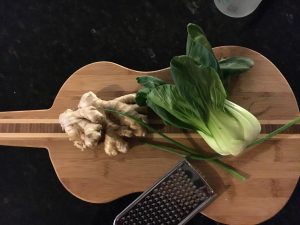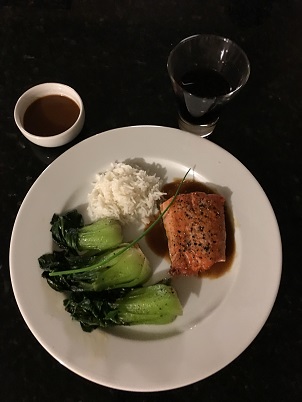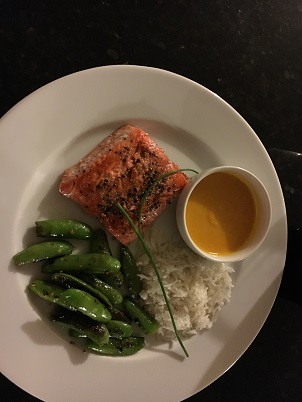In the summer of my freshman year in college years ago, my best friend Aimiya and I hang out with my grandpa Jack and his friends during their salmon fishing excursion in Alaska. In that memorable trip, we learnt about the various type of salmon including Chinook salmon and sockeye salmon, and the versatile “ulu” knife.
Aimiya and I were roommates through college and grad school. When she took up a science research job in Japan, we promised we would visit each other at least once a year. Last year I spent a week in Osaka and Kobe in Japan with her. We visited the Nada area during my stay and I developed a deep appreciation about sake production – including the heavenly “miyamizu” water and “Yamada Nishiki” rice.

Last month, both Grandpa Jack and Aimiya were visiting with us – there was one night overlapping their visits. My husband and I created this special grilled salmon with two Japanese-inspired sauces for dinner that night – in honor of that fantastic summer we shared with Grandpa Jack in Alaska back in our freshman year, and my visit to sake production in Nada. Here are the variations of sides and sauces to accompany our salmon entrée that evening:
- Grilled salmon with sake-soy sauce served with sauté baby Bok Choy and basmati rice
- Grilled salmon with miso-ginger sauce served with sauté sugar snap peas and Jasmine rice.
Recipe for our grilled salmon with sake-soy sauce or miso-ginger sauce
How to prepare our grilled salmon?
- We chose a skin-on sockeye salmon, about one-inch thick. Skin helps to hold the salmon together, and not to stick onto the grill.
- Tip: check for pin bones. Use a long-nose plier to pull out the pin bones.
- Preheat your grill to medium high heat. Tip: clean and oil your grate.
- Season your salmon with olive oil, kosher salt and coarse ground black pepper.
- Cook the salmon skin-side down if you prefer crispy skin. About four minutes per side for a one-inch thick salmon. If crispy skin is not your taste, you can cook the no-skin side (presentation side) first.
- Reduce heat to medium after the first flip. Cook another four minutes on the other side of the salmon.
- If you prefer, you can broil your salmon in the oven, it takes just about four minutes to cook each side.
- Or, if you like, you can cook the salmon on the stove top, medium high heat for four minutes per side.
How to make our sake-soy-ginger sauce?

- 2/3 cup vegetable broth
- 1/3 cup of unfiltered nigori sake
- 3 tablespoon traditional brewed soy sauce
- 1 tablespoon of unseasoned rice vinegar
- 1 tablespoon of finely grated ginger
- 1 teaspoon of honey
- Put all ingredients in a medium heat sauce pan, bring to a boil
- Simmer until sauce reduced by half, about 10 minutes.
- Stir in a tablespoon of unsalted butter before serving
How to make our miso-carrot-ginger sauce?

- 4 tablespoons vegetable oil
- 1 ½ tablespoons of white miso
- 2 tablespoons of unseasoned rice vinegar
- 1 tablespoon of finely grated ginger
- 2 carrots, peeled and chopped
- ½ teaspoon sugar
- ½ teaspoon of ground white pepper
- Combine all ingredients in a food processor, process until smooth.
- This miso-ginger sauce has the most beautiful orange-yellow color. It can also be used as a salad dressing.
Wine Pairing with grilled salmon
Here are our wine pairings – grilled salmon with sake-soy sauce, or miso-ginger sauce:
- Pinot Noir. We served a vintage from Sonoma, California; another from Willamette valley, Oregon.
- Sake. Aimiya brought us a beautiful Ginjo grade sake, we called it “single malt” sake. 50% of each grain of rice that produced this sake has been milled (Japanese term “Seimaibuai”)
Do we have the right pairings for our grilled salmon with sake-soy sauce, or miso-ginger sauce?
- Our Pinot Noir has black cherry and sandalwood aroma, faint scent of oak and spicy. Pinot Noir always pairs well with mild flavor fish like salmon and swordfish.
- Our salmon is simply grilled – it is perfect even without sauce, to marry happily with pinot noir. We served our sauces on the side – to give our family members the option to drizzle the right amount of sauce they prefer on the salmon.
- Both of our sake-soy sauce and miso-ginger sauce are not as sweet as Teriyaki sauce, but more aromatic and frequent with scent of ginger and soy undertone.
- Scent of ginger goes really well with the sandalwood aroma from the Pinot Noir. We have ginger in both of the Japanese inspired sauces.
- Pinot Noir pairs well with umami. Both our sake-soy-ginger sauce and miso-carrot-ginger sauce have the umami components in them.
- The slight faint scent of oak in our Pinot Noir pairs well with the light smoke scent of our grilled salmon impart from the charcoal.
- The nutty scent of the basmati rice (served with the sake soy ginger sauce) goes well with the grilled salmon and the sandalwood scent from our pinot noir.
- The Jasmine rice (served with the miso carrot ginger sauce) pairs well with the floral jasmine undertone of the pinot noir.
- Pinot noir pairs better with cooked (versus raw) vegetables.
- We served sauté baby Bok Choy and sugar snap peas with our grilled salmon.
- The cooked vegetables complement the sauces and allow the beautiful salmon to be the star of the evening.
- Special note on sake: you might be wondering how the beautiful Ginjo sake faired. This sake was special, like an exceptional single malt, it is best to enjoy it by itself. We had it with salmon sashimi (our appetizer) as we were making the sake-soy-ginger sauce and the miso-carrot-ginger sauce. Grandpa Jack does not usually drink sake, and he liked this Ginjo sake very much.
- When you apply the local rule to pairing, sake goes beautifully with both of our Japanese-inspired sauces. We have ginger in both sauces, sake in the sake-ginger sauce, and miso in the miso-ginger sauce. The elements of ginger, sake and miso are natural pairings with sake.
Final thoughts:
My sister (who lives in Oregon) told me that Oregon Pinot Noir is a proven classic pairing of northwest salmon, and we concur. Pinot noir is soft on tannin and long on acidity – these elements making it versatile and agreeable with a wide variety of grilled fish.
You might like to read our blog on: What is special about Pinot Noir?
For our pairing, our friends at our dinner table were pleasantly surprised that Pinot Noir goes very well with our Japanese-inspired sauces. In our experience, Pinot Noir complements any sauce containing soy or/and ginger.
Wine tips about Pinot Noir:
- If you are to pick a wine to please both your red and white wine friends, the lush Pinot Noir is always an excellent choice of equalizer for both camps.
- Temperature. In our experience, we find that Pinot Noir serving at 62°F – 58°F works the best with this salmon pairing.
Did you know:
- Pinot Noir was the first fruit in the genome sequence research. The sequence was performed by French researchers over a decade ago back in 2007. The knowledge gathered from the research helps us to better understand the evolution of grapes and wines.
- Pinot Noir is called Spatburgunder in Germany. And, Spatburgunder carries a slightly lighter hue than Pinot Noir in the States or that in France. Spatburgunder, like our Pinot Noir, has a wide range of aromatic bouquets including blackberry and cherry.
This special dinner, created by my loving husband, and sharing it with two people I love dearly – Grandpa Jack and my best friend Aimiya. It is indeed the very perfect pairings. Cheers!